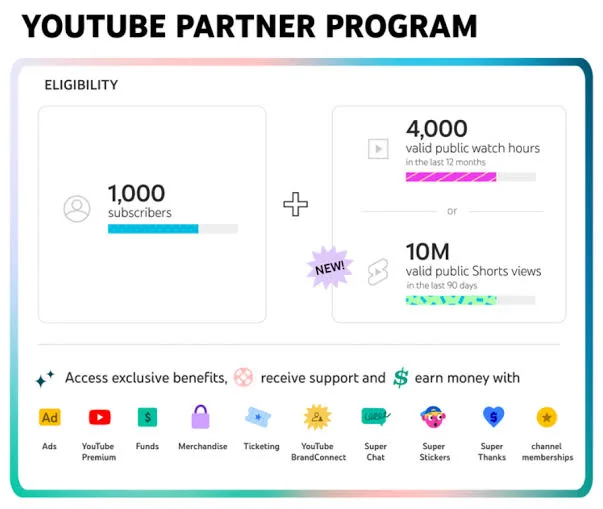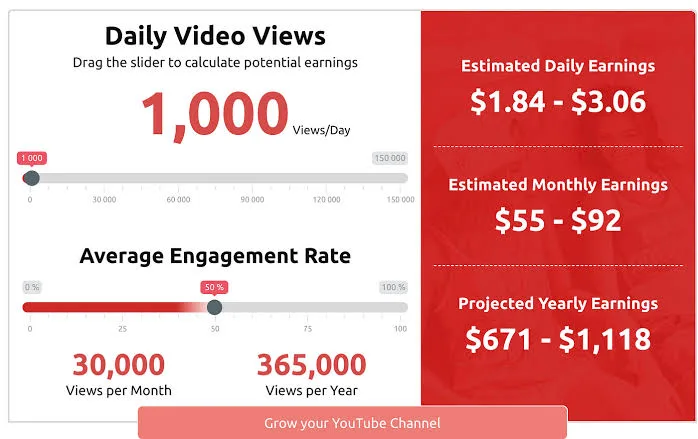YouTube has evolved from a simple video-sharing platform into a multi-billion-dollar industry where content creators can earn substantial income. One of the most commonly asked questions by aspiring YouTubers is: “How much money can you earn from 1,000 views?” While it may seem like a straightforward query, the answer varies depending on numerous factors, including niche, audience demographics, engagement rates, monetization strategies, and ad types.
This article delves deep into the elements that affect YouTube earnings per 1,000 views, often referred to as CPM (Cost Per Mille), and breaks down the data to help creators understand the income potential from YouTube.
Understanding YouTube Monetization and CPM:
YouTube monetization begins when a channel meets the eligibility criteria: 1,000 subscribers and 4,000 watch hours in the past 12 months. Once accepted into the YouTube Partner Program (YPP), creators can earn from ad revenue, memberships, Super Chats, and more. CPM is the amount advertisers pay per 1,000 ad impressions. However, YouTube takes 45% of the ad revenue, so creators receive 55% of the total CPM.

Key Points:
- YouTube Partner Program is mandatory for ad revenue.
- CPM varies across regions, topics, and audience.
- Actual earnings per 1,000 views depend on whether ads are shown and watched.
- RPM (Revenue Per Mille) is more accurate for earnings—it shows the actual revenue earned per 1,000 views after YouTube’s cut.
Factors Influencing Earnings From YouTube:
The CPM isn’t a fixed number. It is influenced by multiple dynamic factors that can either boost or reduce your earnings per 1,000 views. These elements help advertisers determine the value of placing ads on your content.
Influencing Factors:
- Geographic Location – Advertisers pay more for audiences in developed countries like the USA, UK, and Canada.
- Niche or Content Category – Finance, tech, and real estate channels attract higher CPMs compared to entertainment or vlogs.
- Viewer Device – Desktop viewers tend to generate higher CPMs than mobile viewers.
- Audience Demographics – Age, interests, and income level affect advertiser targeting.
- Seasonality – Advertisers spend more during Q4 (October to December), increasing CPM.
- Engagement Level – Higher engagement boosts video ranking and ad relevancy, leading to higher CPM.
Understanding these factors helps creators strategize their content to improve monetization.
How Audience Location Affects Income Per 1,000 Views?
One of the most significant factors that affect YouTube income per 1,000 views is where your viewers are located. Advertisers spend different amounts in different regions, based on market potential and purchasing power.
For example, audiences from countries like the USA, Canada, Australia, and the UK often result in higher CPMs—sometimes up to $20—because advertisers in those regions have bigger budgets and are willing to pay more to reach customers. In contrast, views from countries like India, Philippines, or Indonesia may have CPMs as low as $0.50 to $2.
Key Insights:
- Advertisers use location-based targeting to optimize ad spend.
- Even with the same number of views, a creator targeting high-paying regions can earn 4–10 times more.
- Use YouTube Analytics to track your audience’s country-wise distribution and adjust content or language if needed.
So, if your goal is to increase income per 1,000 views, it’s worth focusing on attracting an international audience from countries with higher ad spends.
The Role of Video Length and Watch Time in Revenue Per 1,000 Views:
Video length and viewer retention play a crucial role in determining how much money you can earn per 1,000 views. YouTube allows creators to insert multiple ads (mid-rolls) in videos that are over 8 minutes long, increasing total ad impressions—and, in turn, your earnings.
When viewers watch longer and don’t skip ads, the RPM increases significantly. Longer videos that keep viewers engaged tend to perform better with the algorithm and advertisers, making them more profitable.
Quick Breakdown:
- Videos over 8 minutes = multiple ad slots = higher revenue potential.
- High watch time boosts channel credibility and ad relevancy.
- Higher retention = better ad engagement = higher CPM.
Creators who master storytelling or educational formats can use this to their advantage by producing longer videos without making them boring. Balancing quality content with strategic length is key to boosting income per 1,000 views.
Realistic Earnings From 1,000 Views in YouTube:
Many new creators overestimate how much they can earn from YouTube. On average, earnings per 1,000 views can range between $0.50 to $7, depending on the factors discussed earlier.

Illustrative Scenario:
You create an educational video with an average RPM of $2. If the video gets 10,000 views, your earnings would be around $20.
Breakdown:
- 10,000 views × $2 RPM = $20
- If CPM is $4, your actual share is $2.20 after the 45% cut.
Tip:
Don’t rely on a single video. Create content consistently, and optimize for higher RPM through improved audience targeting, longer watch time, and better engagement.
Ways to Increase YouTube Income Per 1,000 Views:
If your current RPM is low, there are actionable strategies to increase your revenue per 1,000 views.
- Choose a High-CPM Niche: Finance, marketing, or business content performs better.
- Create Long-Form Videos: Videos longer than 8 minutes allow mid-roll ads, increasing revenue.
- Target High-Paying Countries: Use analytics to learn where your audience comes from and adjust content to attract viewers from top-paying countries.
- Optimize SEO: Proper use of keywords in titles and descriptions increases visibility to advertisers.
- Engage with Your Audience: Encourage likes, comments, and subscriptions to improve watch time and ranking.
These adjustments not only improve CPM but also strengthen channel credibility and growth.
Alternative Revenue Streams Boosting Earnings From YouTube:
Ad revenue is just one piece of the puzzle. Diversifying income sources significantly increases overall earnings per 1,000 views and raises your RPM.
Additional Monetization Methods:
- Affiliate Marketing: Promote products and earn commissions.
- Brand Sponsorships: Paid promotions from companies relevant to your audience.
- Channel Memberships: Offer exclusive content to paying subscribers.
- Merchandise Sales: Sell custom products or digital downloads.
- Super Chat and Stickers: Earn from live stream donations.
For instance, a channel with 1,000 views may earn just $2 from ads, but $50 from a single affiliate sale promoted in the video. These streams compound your earnings and reduce dependency on YouTube’s ad system.
Conclusion:
Earning income from YouTube is possible, even with modest view counts, as long as creators understand how CPM and RPM work and leverage every tool available to increase revenue. While the average earnings per 1,000 views may not be high for all creators, strategic content creation, audience targeting, and monetization diversification can lead to sustainable income. Rather than chasing viral success, consistent value delivery and niche focus pave the way to long-term profitability.
FAQs:
YouTube pays anywhere between $0.50 to $7 per 1,000 views depending on the niche, country, and engagement.
CPM is what advertisers pay before YouTube’s cut, while RPM shows your actual earnings from all revenue sources after the cut.
Finance, investing, technology, digital marketing, and business-related content typically have the highest CPM.
Yes. Channels with targeted, high-CPM content and diversified income streams can earn well even with lower views.
Choose profitable niches, create longer videos, target top-paying countries, and use affiliate marketing or brand deals.
